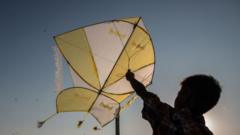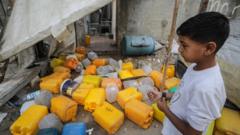Despite warnings from authorities, kids continue to fly kites in perilous proximity to Jakarta’s airport, igniting a longstanding conflict between tradition and safety.
Kites vs. Planes: The Rising Tensions Over Kite Flying Near Jakarta Airport

Kites vs. Planes: The Rising Tensions Over Kite Flying Near Jakarta Airport
Children's love for kite flying clashes with aviation safety concerns near Soekarno-Hatta International Airport.
At a picturesque paddy field just two kilometers from Soekarno-Hatta International Airport, children are engaged in a thrilling tug of war—not just with each other over kite strings, but with airport authorities trying to ensure flight safety. The vibrant rustling of kites is often overshadowed by the deafening roar of planes overhead. Among the young kite flyers, seven-year-old Atif expresses a mix of defiance and vulnerability: “In the past, my friends and I would run away when an officer came. Now I’m braver... If my kite is taken, it's sad, but I can always make another one.”
Kite flying is a beloved pastime across Indonesia, especially during summer vacations. However, airport officials have raised alarms that kites can interfere with aircraft operations, posing severe hazards. Air-traffic controller AirNav Indonesia reported that over a span of three days in early July, kites disrupted 21 flights, necessitating diversions and aborted landings. Such incidents have prompted officials like Putu Eka Cahyadi, the head of the airport authority, to label kites as "serious risks to flight safety."
Past accidents underscore these fears. In July 2024, a helicopter in Bali crashed after becoming entangled in kite strings, leading to injuries among its five passengers. In a separate incident, a plane arriving at Soekarno-Hatta had kite materials found in its engine. Following such events, the airport established a task force aimed at curbing kite flying in critical areas, which remains a challenge five years later.
Transport Minister Dudy Purwagandhi urged regional authorities across Indonesia to proactively mitigate the dangers that kites pose to aviation. While officials have attempted to introduce alternative sports—offering children footballs and badminton racquets—kite flying remains deeply ingrained in the nation's cultural traditions. With traditional kites crafted from leaves, colorful paper, and cloth, the activity is a celebrated aspect of various Indonesian customs, from harvest ceremonies to spiritual offerings in Bali.
Kite expert Asep Irawan emphasizes the significance of kite flying, though he acknowledges the risks associated with inexperienced young flyers. Nearby, children confess their struggles to find safe spaces for their beloved hobby, as Jakarta has seen a dramatic reduction of urban green spaces—down 31% from 2000 to 2020—due to urbanization.
In the face of potential legal consequences—individuals caught flying kites near airports risk imprisonment or hefty fines—enthusiasts continue to pursue their passion. Rasha, a determined 17-year-old who crafts and sells kites, reflects on the dilemma facing local youth: “There's nowhere else around here. It is pretty dangerous. But once your kites have been taken away, you stop being afraid.”
As these children navigate the precarious balance between cultural tradition and safety, the patch of land near Soekarno-Hatta has become a hub for kite competitions and shared camaraderie, showcasing the enduring appeal of this age-old pastime amidst the clouds above.
Kite flying is a beloved pastime across Indonesia, especially during summer vacations. However, airport officials have raised alarms that kites can interfere with aircraft operations, posing severe hazards. Air-traffic controller AirNav Indonesia reported that over a span of three days in early July, kites disrupted 21 flights, necessitating diversions and aborted landings. Such incidents have prompted officials like Putu Eka Cahyadi, the head of the airport authority, to label kites as "serious risks to flight safety."
Past accidents underscore these fears. In July 2024, a helicopter in Bali crashed after becoming entangled in kite strings, leading to injuries among its five passengers. In a separate incident, a plane arriving at Soekarno-Hatta had kite materials found in its engine. Following such events, the airport established a task force aimed at curbing kite flying in critical areas, which remains a challenge five years later.
Transport Minister Dudy Purwagandhi urged regional authorities across Indonesia to proactively mitigate the dangers that kites pose to aviation. While officials have attempted to introduce alternative sports—offering children footballs and badminton racquets—kite flying remains deeply ingrained in the nation's cultural traditions. With traditional kites crafted from leaves, colorful paper, and cloth, the activity is a celebrated aspect of various Indonesian customs, from harvest ceremonies to spiritual offerings in Bali.
Kite expert Asep Irawan emphasizes the significance of kite flying, though he acknowledges the risks associated with inexperienced young flyers. Nearby, children confess their struggles to find safe spaces for their beloved hobby, as Jakarta has seen a dramatic reduction of urban green spaces—down 31% from 2000 to 2020—due to urbanization.
In the face of potential legal consequences—individuals caught flying kites near airports risk imprisonment or hefty fines—enthusiasts continue to pursue their passion. Rasha, a determined 17-year-old who crafts and sells kites, reflects on the dilemma facing local youth: “There's nowhere else around here. It is pretty dangerous. But once your kites have been taken away, you stop being afraid.”
As these children navigate the precarious balance between cultural tradition and safety, the patch of land near Soekarno-Hatta has become a hub for kite competitions and shared camaraderie, showcasing the enduring appeal of this age-old pastime amidst the clouds above.
















